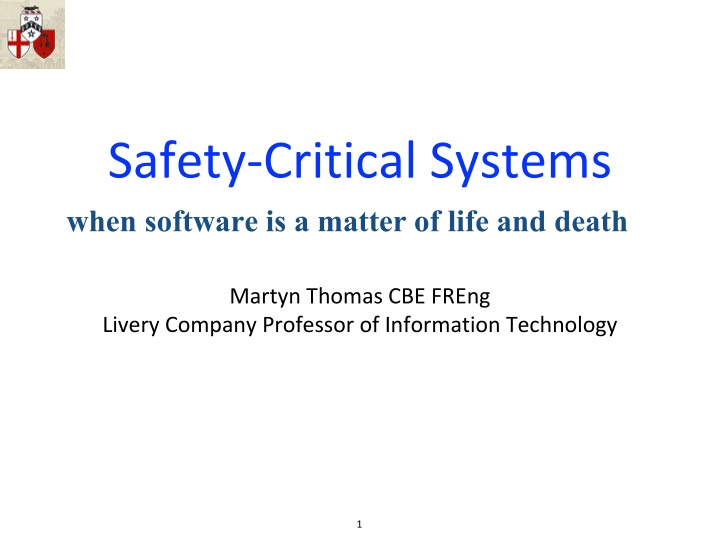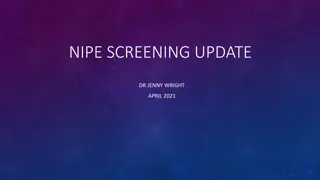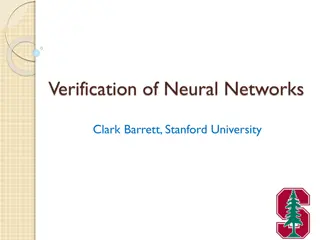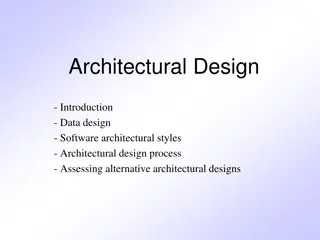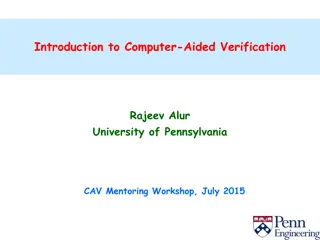Software in Safety-Critical Systems: A Critical Examination
Software plays a crucial role in safety-critical systems where failure could lead to serious consequences. This text delves into the causes of accidents, the intersection of safety and engineering, internationally recognized standards, and the application of established safety principles in software-based safety systems.
Download Presentation

Please find below an Image/Link to download the presentation.
The content on the website is provided AS IS for your information and personal use only. It may not be sold, licensed, or shared on other websites without obtaining consent from the author.If you encounter any issues during the download, it is possible that the publisher has removed the file from their server.
You are allowed to download the files provided on this website for personal or commercial use, subject to the condition that they are used lawfully. All files are the property of their respective owners.
The content on the website is provided AS IS for your information and personal use only. It may not be sold, licensed, or shared on other websites without obtaining consent from the author.
E N D
Presentation Transcript
Safety-Critical Systems when software is a matter of life and death Martyn Thomas CBE FREng Livery Company Professor of Information Technology 1
Software is a matter of life and death What causes accidents? Safety and Engineering How safe is safe enough? Safety and Reliability: how reliable is a program that has run without failing for more than a year? A critical look at the international standards for safety- critical software Safety and security See the lecture transcript for all references 2
Software in Safety-Critical or Safety-Related Systems Software based systems are used in many applications where a failure could increase the risk of injury or even death The lower risk systems such as an oven temperature controller are safety related, whereasthe higher risk systems such as the interlocking between railway points and signals are safety critical. The use of programmable systems in safety applications is relatively recent and has inherited established engineering safety principles - with some difficulty, as we shall see. 3
The Causes of Accidents A motorist, driving their new sports car to an important meeting, skids on a patch of oil at a corner and hits a road sign. What caused the accident? Was it the speed, the oil, the position of the road sign or .. If it was the speed, was the driver trying out the new car, or worrying about the meeting, or late because It it was the oil, was it because an earlier lorry was leaking oil, because of poor maintenance or damage from a pothole or Many accidents do not have a single cause. Several contributory causes coincide and contribute. Safety engineering has to reduce the probability of these separate causes. As software takes on more and more functions in systems, software failures contribute to more accidents, directly or through cyberattacks 4
Many safety engineering principles come from the process industries 5
Early process industry systems Chemical plants and oil refineries, for example Relatively low complexity systems: pipes, valves, reactor vessels, pumps, relays monitored by thermometers and pressure gauges and protected by pressure release valves and alarms. Typical failures caused by corrosion, stuck valves or relays and other physical problems. Safety analysis focused on the reliability of components, redundancy to avoid single points of failure, and calculations of failure probabilities 6
What could possibly go wrong? Hazard analysis attempts to identify all the dangerous states Fault trees are drawn up to analyse how each dangerous state could arise top- down analysis 7
Faults and Failures A fault is an abnormal condition / defect that may lead to a failure A failure is the inability of the component, subsystem or system to perform its intended function as designed A failure may be the result of one or many faults Fault Tree Analysis (FTA) considers how a failure may arise. Failure Modes and Effects Analysis (FMEA) analyses the ways in which each component could fail, and considers the effect this will have on the system. Then the engineers can estimate how reliable each component has to be to achieve the required system reliability 8
Safety and Reliability A system can be safe (because it cannot cause harm) and yet be unreliable (because it does not perform its required functions when they are needed). If your car often fails to start, it may be perfectly safe though very unreliable. In general, if a system can fail safe then it can be safe although unreliable if the failures occur too often. 9
How Safe is Safe Enough? This is a social question, not a technical one! what probability of failure should we permit for the protection system of this nuclear reactor? what probability of failure should we permit for safety-critical aircraft components? how much should we spend to avoid fatal accidents on the roads or railways? From the answers, we can calculate the implicit Value of a Statistical Life (VSL). The results are highly inconsistent 10
Value of a Statistical Life Defined as the additional cost that individuals would be willing to bear for improvements in safety (that is, reductions in risks) that, in the aggregate, reduce the expected number of fatalities by one . Ideally, perhaps (discuss) the NHS and the Department of Transport would use the same figure, so that investment focused on where the greatest savings of life could be achieved, with all deaths considered equal. In reality, a road accident death has a lower VSL than a rail accident death, for example. VSLs also differ internationally (different calculations and different societal attitudes) 11
International VSL values In millions of year 2000 US dollars USA 7.0 UK and Australia 4.2 Austria 3.9 6.5 Hong Kong 1.7 India 1.2 1.5 Japan 9.7 Taiwan 0.2 0.9 Consult my lecture transcript for more countries and references 12
The GB Health and Safety at Work Act (HSWA 1974) it shall be the duty of every employer to ensure, so far as is reasonably practicable, the health, safety and welfare at work of all his employees and it shall be the duty of every employer to conduct his undertaking in such a way as to ensure, so far as is reasonably practicable, that persons not in his employment who may be affected thereby are not thereby exposed to risks to their health or safety. 13
SFIRP / ALARP Reasonably practicable is a narrower term than physically possible a computation must be made by the owner in which the quantum of risk is placed on one scale and the sacrifice involved in the measures necessary for averting the risk (whether in money, time or trouble) is placed in the other, and that, if it be shown that there is a gross disproportion between them the risk being insignificant in relation to the sacrifice the defendants discharge the onus on them. In essence, making sure a risk has been reduced ALARP is about weighing the risk against the sacrifice needed to further reduce it. The decision is weighted in favour of health and safety because the presumption is that the duty-holder should implement the risk reduction measure. To avoid having to make this sacrifice, the duty-holder must be able to show that it would be grossly disproportionate to the benefits of risk reduction that would be achieved. Thus, the process is not one of balancing the costs and benefits of measures but, rather, of adopting measures except where they are ruled out because they involve grossly disproportionate sacrifices. 14
Hazards and Risk A hazard is anything that may cause harm. The risk is the combination of the probability that the hazard will lead to an accident and the likely severity of the accident if it occurs. For each hazard, the risk is assessed and if the risk is not acceptable but can be made tolerable, measures must be introduced to reduce it ALARP. 16
Industry Standards and Guidance on How Safe is Safe Enough? Aviation: Catastrophic failures must be extremely improbable Interpreted as 10-9 / hour or 1 failure per billion hours. Contrast this with guidance in the nuclear industry Reliability claims for a single software based system important to safety of lower than 10-4 probability of failure (on demand or dangerous failure per year) shall be treated with extreme caution . 10-4/ year is about 10-8 /hour 17
Failures: Random & Systematic Most Safety engineering focuses on random failures, caused by stuck valves, corrosion, broken wires or failed components, for example. Design engineers select components that are known to have high enough reliability Software failures are systematic. They occur whenever the triggering conditions arise. 18
Software based Systems Complex: 100,000,000 LoC in a car Failures are systematic but the triggering conditions arise at uncertain intervals Epistemic Uncertainty because we do not fully understand the complex system Aleatoric uncertainty because inputs arise through real-world interactions that are random. Probability is how we reason about uncertainty Remarkably, this is still controversial! 19
What can we learn from testing? We know that Testing cannot show the absence of defects, only the presence of defects But, making some strong assumptions . How reliable is a program that has never failed? 20
How reliable is a program that has run for 10,000 hours without failing? What is its probability of failing per hour (pfh)? We can be 50% confident that the pfh is 10-4or 1 failure in 10,000 hours. If we need 99% confidence that the pfh is 10-4then we need 46,000 hours of failure free operation In general, subject to the following conditions, to show a failure probability of one in N hours, we need N hours of failure free operation for 50% confidence or 4.6N hours for 99% confidence. 21
subject to the following conditions (1) The operating conditions must be identical to the test conditions (so you cannot transfer experience from one context to another, remember Arianne 5) 22
subject to the following conditions (2) all dangerous failures must have been correctly detected and recorded (so auditable evidence is essential) 23
subject to the following conditions (3) no changes are made to the software or system during the test or operational period These are onerous conditions that can rarely if ever be achieved in practice, so safety or reliability arguments that are based on claims about previous operation or testing should be treated with scepticism. 24
Implications for safety certification The aviation standard of a pfh of 10-9 would require 4.6 Billion hours failure free (about 500,000 years) to give 99% confidence 25
N-version programming combining, say 3 10-3systems to get 10-9 This assumes the systems fail independently, but Knight & Leveson showed that they do not Version 1 output inputs Version 2 Voter Version n 26
International Standards IEC 61508 and DO-178 Assign System Integrity levels (SIL IEC 61508) or Design Assurance Levels (DAL DO178) depending on the required failure probability The SIL or DAL determine the development processes that should be followed. But the recommendations are illogical, unscientific and lack supporting evidence (see my lecture transcript) 27
IEC 61508 SILs But there is no evidence that employing all the practices recommended for SIL 4 would actually achieve even SIL 1 with any certainty. 28
Sufficient Evidence? Be explicit about the system properties you are claiming and the assumptions you have made Provide strong and independently auditable evidence that the claimed properties have been achieved Employ staff who are familiar with the application and with rigorous software engineering methods. 29
Final Observations Many safety critical systems are in use and appear to be acceptably safe (even if not demonstrably ALARP) Very few safety cases are open to peer review. Very few are scientifically sound. This should be unacceptable. There is no prospect that it will ever be possible to provide scientifically sound evidence for pfh below 10-5, so formal proof of specific properties seems the safest assurance. Current standards ignore cybersecurity threats almost completely. This is a serious omission. 30
